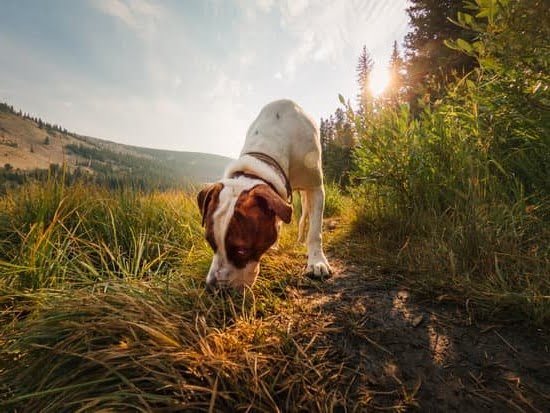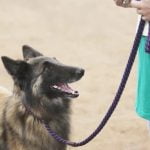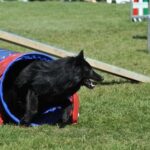House training is often thought to be a task reserved for puppies, but what about older dogs? Many people believe that once a dog reaches a certain age, they are set in their ways and cannot be successfully house trained. However, this is simply a myth. With patience, consistency, and the right approach, it is indeed possible to house train a 5-year-old dog.
The challenge of house training an older dog lies in changing established behaviors and habits. Unlike puppies who are more easily moldable, adult dogs may have already developed certain preferences or routines when it comes to where they eliminate waste. However, this does not make them incapable of learning new habits. By debunking the myth that older dogs cannot be house trained and understanding the challenges involved, owners can approach the process with realistic expectations.
When looking to house train a 5-year-old dog, it is important to consider their psychology and previous experiences. Adult dogs have cognitive abilities and learning capacities that allow them to understand new concepts and adapt their behavior accordingly. Additionally, an older dog’s background, previous training (or lack thereof), and any potential behavioral or medical issues need to be taken into account when developing a training plan.
Understanding the Psychology of a 5 Year Old Dog
When house training a 5-year-old dog, it is essential to understand their psychology and learning capacity. While older dogs may have different cognitive abilities compared to puppies, they are still capable of learning new behaviors and adapting to their environment. However, it’s important to take into consideration an older dog’s previous training, background, and experiences that may affect the house training process.
Adult dogs have more developed cognitive abilities compared to puppies. They possess a greater attention span and are typically more focused during training sessions. However, it’s crucial to be aware of any potential behavior or medical issues that may hinder the training process. For example, if a dog has previously been punished for eliminating indoors or had negative experiences with potty training, they may show reluctance or anxiety during the process.
Additionally, an older dog’s past experiences can influence their ability to learn new habits. If they were previously trained using positive reinforcement techniques and had a good foundation in basic commands, they may be more responsive during the house training process. On the other hand, dogs who lack prior training or have had negative reinforcement may require more patience and consistency.
To successfully train a 5-year-old dog, building trust is crucial. Participating in trust-building exercises such as spending quality time together and engaging in positive activities can help establish a strong bond with your furry companion. This foundation of trust will make them more receptive to your guidance during the house training process.
Establishing a consistent daily routine is also vital when house training an older dog. Set clear schedules for feeding times, bathroom breaks, exercise sessions, and sleep patterns. Dogs thrive on routines and predictability, so following a consistent schedule will help them understand when and where they are expected to eliminate.
To outline these steps:
- Spend quality time together with your dog through trust-building exercises.
- Establish a consistent daily routine for feeding times, bathroom breaks, exercise sessions, and sleep patterns.
By understanding the psychology of a 5-year-old dog and tailoring your approach to their individual needs, you can greatly increase the success of house training them. Patience, consistency, and positive reinforcement techniques play crucial roles in helping older dogs learn new behaviors and develop good habits. Remember to adapt your training methods based on your dog’s background and experiences while building trust and establishing a routine for optimal results.
Building Trust and Establishing a Routine
Establishing trust with an older dog is crucial when it comes to house training. Many dogs may have had negative experiences or inconsistent training in the past, causing them to be hesitant or fearful. Building trust will help create a positive environment where the dog feels comfortable and secure. Patience, understanding, and positive reinforcement are key components in gaining your dog’s trust.
One way to build trust is through trust-building exercises. These exercises include activities such as hand-feeding, grooming, and gentle petting sessions. By engaging in these activities, you can establish yourself as a source of comfort and safety for your dog. It is important to note that each dog may respond differently to these exercises, so it is crucial to read their body language and proceed at a pace that they are comfortable with.
In addition to building trust, establishing a consistent daily routine is vital for effectively house training an older dog. Dogs thrive on routine and structure, so having a predictable schedule will help them understand what is expected of them. This includes setting specific times for feeding, bathroom breaks, exercise, and even playtime. Consistency allows the dog to anticipate their needs, making it easier for them to follow the desired behavior during house training.
| Activity | Time |
|---|---|
| Feeding | 8:00 am / 6:00 pm |
| Bathroom Breaks | 8:30 am / 12:30 pm / 4:30 pm /etc. |
| Exercise | 9:00 am / 5:00 pm |
| Training Sessions | 10:00 am / 3:00 pm |
By setting a routine and sticking to it, you will not only help your dog understand their expectations but also make the house training process smoother and more effective.
Remember, building trust and establishing a routine are foundational steps in successfully house training an older dog. By taking the time to build trust through trust-building exercises and maintaining a consistent daily routine, you are laying the groundwork for a positive training experience.
Refresher Training
When house training a 5-year-old dog, it is important to include refresher training on basic commands as part of the process. Even if your dog has been previously trained, reinforcing their understanding of commands like “sit,” “stay,” and “come” can greatly aid in the house training journey. Refresher training helps to establish clear communication between you and your dog, ensuring that they understand what is expected of them during the house training process.
Benefits of Reinforcing Basic Commands
Reviewing basic commands with your 5-year-old dog has numerous benefits. Firstly, it strengthens the bond between you and your furry friend. By working together and practicing these commands, your dog will learn to trust and rely on you as their leader. This trust will make them more likely to follow your instructions during the house training process.
Secondly, reinforcing basic obedience commands allows you to have better control over your dog’s behavior. When accidents happen indoors or undesirable behaviors are exhibited, having a solid foundation of obedience training will make it easier to redirect their attention or correct their actions.
Implementing Obedience Training
Implementing obedience training alongside house training involves breaking down each command into small steps that are easily understood by your 5-year-old dog. Start in a quiet, distraction-free environment and use positive reinforcement techniques such as treats, praise, and rewards.
Begin with simple commands like “sit” or “stay.” Use treats as incentives for your dog to perform these actions correctly. Gradually increase the difficulty level by incorporating distractions such as noises or other people around them.
Consistency is key when reviewing basic commands during the house training process. Practice these commands regularly throughout the day in short sessions, keeping them engaging and enjoyable for both you and your 5-year-old dog.
By taking the time to review and reinforce basic obedience commands, you are setting your older dog up for success in their house training journey. This refresher training not only helps to establish clear communication and control but also strengthens the bond between you and your furry companion.
Punishment-Free Approach
Promoting Positive Reinforcement for House Training
When it comes to house training a 5-year-old dog, using a punishment-free approach with positive reinforcement techniques is highly recommended. Positive reinforcement is the most effective and humane method for teaching dogs appropriate behavior. This technique involves rewarding your dog for desirable actions or behaviors, rather than punishing them for mistakes or accidents.
Using Treats, Praise, and Rewards
Positive reinforcement can be implemented through the use of treats, praise, and rewards. When your dog successfully eliminates outside in their designated spot, promptly reward them with verbal praise, physical affection such as petting or gentle play, and a treat. The key is to reward your dog immediately after they perform the desired behavior so that they can associate the action with the reward.
It’s essential to use high-value treats that your dog finds especially enticing during house training sessions. This will serve as a powerful motivator for them to continue displaying the desired behavior. Additionally, offering variety in your rewards can help keep your dog engaged and excited to learn.
The Potential Negative Effects of Punishment-Based Training
Punishment-based training methods should be avoided during house training as it can have detrimental effects on your dog’s overall well-being and progress in training. Physical punishment like hitting or yelling not only causes unnecessary stress and anxiety but also damages the trust between you and your dog.
Furthermore, punishment may lead to other behavioral issues such as fear-based aggression or avoidance behaviors. Instead of teaching your dog what they should do, punishment often confuses them about what they did wrong without providing them clear guidance on appropriate behavior.
By using positive reinforcement techniques instead of punishment, you create an environment of trust, respect, and understanding between you and your furry companion. This approach sets the foundation for successful house training by focusing on encouraging desired behaviors rather than punishing mistakes.
Consistency in Bathroom Breaks and Rewards
Once you have established trust with your 5-year-old dog and set a consistent routine, it is important to maintain consistency in bathroom breaks and rewards. Consistency plays a crucial role in reinforcing the desired behavior and teaching your dog where and when they should relieve themselves.
Advising on the frequency and duration of bathroom breaks for a 5-year-old dog
To ensure successful house training, it is important to establish a consistent schedule for bathroom breaks. The frequency and duration of these breaks will depend on your dog’s specific needs. On average, adult dogs need to relieve themselves three to four times a day. However, keep in mind that some dogs may require more frequent breaks, especially if they have any medical conditions or are adjusting to new surroundings.
When determining the duration of each bathroom break, consider factors such as your dog’s size, breed, and overall health. Smaller dogs tend to have smaller bladders and may need more frequent but shorter breaks compared to larger breeds. If you are unsure about the appropriate duration for your 5-year-old dog, consult with your veterinarian for guidance.
Highlighting the importance of being consistent in rewarding desired behavior during bathroom breaks
Consistency in rewarding desired behavior during bathroom breaks is essential for teaching your 5-year-old dog where it is acceptable to relieve themselves. When your dog successfully eliminates in the designated area (e.g., outdoors or on a pee pad), immediately reward them with praise, treats, or their favorite toy. This positive reinforcement helps reinforce the connection between going potty in the correct spot and receiving rewards.
It is crucial to be consistent with your rewards every time your dog eliminates appropriately. By doing so, you’re providing clear feedback and motivation for them to continue exhibiting this desired behavior. Additionally, consistency will help prevent confusion on what is expected of them during bathroom breaks.
Suggesting the use of cues or phrases to associate with the bathroom routine
Using cues or phrases can be helpful in establishing a routine and associating it with bathroom breaks. Choose a specific word or phrase, such as “go potty” or “do your business,” that you consistently use when taking your dog outside or to their designated area. Repetition and consistency will help your dog understand these cues and connect them with the action of relieving themselves.
When using the cue or phrase, say it in a calm and positive tone so that your dog learns to associate it with their bathroom routine. Eventually, they will begin to understand what is expected of them when they hear the cue or phrase, making it easier for them to follow the desired behavior during future bathroom breaks.
By maintaining consistency in both bathroom breaks and rewards, you are setting your 5-year-old dog up for success in their house training journey. Remember to be patient and persistent throughout this process as each dog learns at their own pace.
Encouraging Gradual Independence and Freedom
When house training a 5-year-old dog, it is important to gradually encourage their independence and freedom within the house. As dogs become more confident and reliable in their bathroom habits, it is crucial to give them the opportunity to explore different areas of the home without having accidents.
This section will discuss the process of gradually increasing a dog’s space and freedom, addressing potential setbacks, and providing tips on gradually leaving the dog alone without any accidents occurring.
To encourage gradual independence and freedom, start by confining the dog to a specific area in the house that is easily accessible for bathroom breaks. This can be accomplished through the use of baby gates or crates. Over time, as the dog becomes more consistent with their bathroom habits, slowly expand their access to other rooms within the house. It is important to continuously supervise them during this process to prevent any accidents.
Additionally, when expanding their freedom within the house, do so in small increments. For example, allow them access to one additional room at a time for short periods until they have proven themselves reliable in each area. Gradually increasing their space will prevent overwhelming them and reduce any potential accidents or regression in their behavior.
During this process, accidents may still occur despite careful supervision and expanded freedom. It is important not to punish or scold the dog when accidents happen as this can lead to anxiety or setbacks in their progress. Instead, clean up any accidents calmly and without drawing attention to them.
Troubleshooting
House training a 5-year-old dog can sometimes come with its fair share of challenges and setbacks. It’s important to remember that every dog is unique, and what works for one may not work for another. Being prepared to face obstacles along the way will help you navigate through the training process more effectively.
One common challenge that can arise during house training is regression. Even if your dog has made significant progress in their training, they may still have accidents indoors occasionally. This could be due to factors such as a change in routine, stress, or even health issues. When faced with regression, it’s crucial to remain patient and consistent in your training methods. Go back to basics by reinforcing positive behavior and being diligent in taking them outside frequently.
Another setback that you may encounter is marking or territory-related behaviors. Dogs may mark their territory by urinating on furniture or other objects inside the house. This behavior can be more prevalent in unneutered male dogs but can also occur in females or neutered males. To address this issue, it’s essential to understand the underlying cause. Consulting with a veterinarian or professional trainer can provide valuable insights and strategies tailored to your dog’s specific needs.
Anxiety is another challenge that some older dogs may face during house training. Dogs who have experienced trauma or have been adopted from shelters may exhibit anxious behaviors that make the training process more difficult. In these cases, it’s important to approach training with patience, understanding, and compassion. Implementing calming techniques such as using pheromone diffusers or providing a safe space for your dog can help reduce anxiety levels and facilitate the learning process.
Remember that setbacks are part of the journey when house training any dog, regardless of age. It’s crucial not to get discouraged during these moments but instead focus on finding solutions and remaining persistent in your efforts. Consistency is key – continue implementing positive reinforcement techniques, reward desired behavior, and be consistent with their bathroom break schedule. With time, patience, and dedication, you can overcome challenges and setbacks to successfully house train your 5-year-old dog.
Conclusion
In conclusion, house training a 5-year-old dog is definitely possible with patience, consistency, and the right approach. While there may be challenges and setbacks along the way, understanding the psychology of an older dog and building trust and routine are key elements to success. By establishing a clear schedule, reviewing basic commands, using positive reinforcement techniques, and gradually increasing the dog’s independence, owners can achieve their goal of having a well-behaved and house-trained pet.
Throughout the training process, it is important to reflect on the journey and celebrate the accomplishments that have been made. From overcoming initial obstacles to seeing progress in your dog’s behavior, each step forward should be acknowledged and embraced. Take pride in the hard work you have put in as a responsible pet owner.
It is my hope that this article has provided valuable insights into house training a 5-year-old dog and encouraged readers to embark on this rewarding journey. Remember that success comes with persistence and patience. With time and consistent effort, you can turn your untrained adult dog into a well-behaved companion who understands the rules of your home. So why wait? Start training today and enjoy the benefits of living harmoniously with your furry friend.
Frequently Asked Questions
Is it too late to potty train a 5 year old dog?
It is not necessarily too late to potty train a 5-year-old dog, although it may be more challenging compared to training a younger dog. At this age, the dog may have already developed certain habits and routines, making it important to approach the training with patience and consistency.
Introducing a regular schedule for bathroom breaks and using positive reinforcement techniques can still be effective in teaching the dog where to go potty. It is essential to remember that older dogs might have medical conditions or other factors affecting their ability to control their bladder, so consulting with a veterinarian is advisable before initiating any training program.
Can I still train my 5 year old dog?
Yes, you can definitely train your 5-year-old dog! Dogs are capable of learning at any age, although it may require some additional patience and understanding. By using positive reinforcement methods such as treats, praise, and rewards for desired behaviors, you can effectively teach your older dog new commands and tricks.
Consistency and repetition are key when training an adult dog, as they may need more time to grasp new concepts compared to puppies. Building a strong bond based on trust and clear communication will contribute to successful training outcomes with your 5-year-old canine companion.
At what age is it too late to house train a dog?
House training a dog can typically be done at any age as long as the necessary time and effort are invested. While puppies tend to learn faster since they are in the early stages of development, older dogs can still be house trained successfully.
However, it is important to note that some older dogs may require additional patience and consistency during the process due to ingrained habits or potential health issues. The ideal age for house training typically starts around 12 weeks old when puppies have better control over their bladder muscles but with proper techniques, even adult dogs can learn how to appropriately relieve themselves indoors or outdoors with consistent guidance from their owners.

Welcome to the blog! I am a professional dog trainer and have been working with dogs for many years. In this blog, I will be discussing various topics related to dog training, including tips, tricks, and advice. I hope you find this information helpful and informative. Thanks for reading!





